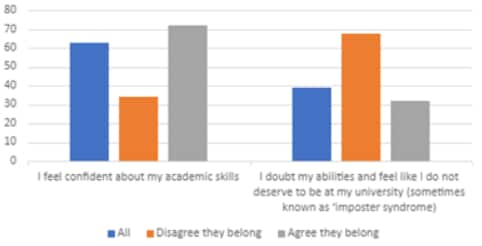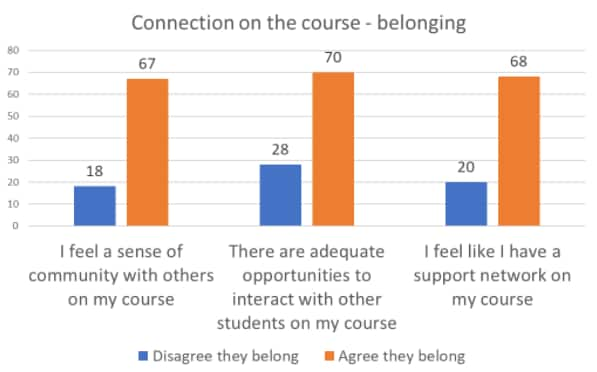Belonging – what makes it and breaks it?

The link between belonging and student success is well established. A sense of belonging was strongly associated with both academic and social engagement at university a decade ago as part of the Higher Education Academy’s “What works?” programme. In fact, it was stated as the key variable in whether students persist with their studies and are successful. This “sense of belonging” while at university can make or break students’ overall experience and their success.
The isolating experience of studying throughout Covid-19 has pushed ‘belonging’ back to the forefront at universities, supported by the work of the UPP Foundation Student Futures Commission that has highlighted the importance of helping students regain their sense of ‘belonging’ at their university.
In the autumn of 2021 Pearson and Wonkhe embarked on a year-long study of belonging and inclusion. The aim? To better understand which areas impact students’ sense of belonging and support the sector in its efforts to “build back” student experience and engagement.
During November 2021 in partnership with 15 students’ unions, 13 in England, one in Scotland, and one in Wales, we distributed a student survey on belonging and inclusion, achieving 5,233 responses with a good demographic spread.
The survey explored a range of possible dimensions of the experience of belonging – feeling “settled in”, personal priorities and academic confidence, the way the course is run, sense of connection and inclusion on the course, connections outside the course (extra-curricular activities), inclusion in the university, sense of safety, being valued and empowered, feelings of happiness and loneliness. The results showed clear associations between sense of belonging and all these different factors.
Overarching findings from the survey
- 69% of respondents agree they belong at their university. Just under one in ten (9%) disagree they belong – and it’s this group we report as “students who do not feel they belong.” One in five (22%) neither agree nor disagree.
- The state of students’ self-assessed mental health was most consistently and dramatically associated with their sense of belonging across all the different areas we explored. However, we can’t say for sure whether belonging influences mental health or whether it’s the other way around.
- Demographic differences (factors like prior education, ethnicity, or gender) did not have a significant impact on students’ sense of belonging in most groupings.
- Mental health, academic confidence or ‘deserving to be at university’, inclusion and feeling connected were clearly associated with a sense of belonging.
- Students with disabilities had lower mental health and lower levels of belonging. They generally scored lower for every area we asked about.
- Overwhelmingly, students think that developing closer and more friendships will help them to feel a greater sense of belonging.
Areas of interest
Mental health
It isn’t a huge surprise to find that students with lower levels of self-assessed mental health are less likely to feel a sense of belonging than students with average and above levels of mental health.
60% of students scored themselves 6 or more out of 10 for mental health and the other 40% scored themselves 5 or lower (referred to below as those with ‘below average mental health’). Half of students (52%) with below average mental health scores say they feel that they belong compared with 80% of those with average and above mental health.
However, we weren’t expecting to see low mental health linked to more negative responses to questions across every aspect of university life, whether it was about connections at course or university level, confidence, how inclusive they found course content or whether they felt they could speak freely at university. It’s worth noting that mental health is not “fixed” to the same extent as some of the other categories and that students may experience the onset or worsening of a mental health condition at any time. Significant proportions of students who report average or better mental health and/or agree they belong at university also report feelings of loneliness, self-doubt, and exclusion.
The dramatic impact of low mental health on all aspects of the university experience backs up the investment and focus that many universities are placing on this area and highlights the importance of preventative measures as well as remedial. These findings speak to the value of weaving mental health and wellbeing support and inclusive practice into every stage of the student lifecycle, including courses and extra-curricular activities as well as welcome and transition.
Confidence and imposter syndrome
We asked students about academic confidence and “imposter syndrome”. The results suggest a strong link between how confident a student feels and whether they feel a sense of belonging. Of the students who do not feel they belong at university, only 34% say they are confident in their academic ability. Overall, 39% agree that they experience imposter syndrome (which we defined in the survey as ‘feeling like you doubt your abilities and whether

you deserve to be at university’). Again we see that 68% of those who do not feel they belong admit to feeling imposter syndrome compared to 32% of those who feel they do belong.
There is surprisingly little difference between levels of academic confidence and imposter syndrome between first and final year students. However, given the final year students who took part in this survey had spent the majority of their university life under Covid restrictions it’s hard to know how much this has negatively impacted their confidence levels.
Confidence is certainly an area where universities can proactively support students. Research suggests that helping students to see their progress by offering constructive feedback or having regular low stakes quizzes, can help to build confidence. Encouraging students to identify and address skill gaps, and then nudging them to remediate these gaps can help them to see progression and to build self-awareness.
Community and connection
We looked at students’ connectedness at both course and university level and found low numbers for both. Only 39% of all respondents agreed they feel a sense of connection to their university community. And while numbers are higher at course level, only 55% of all respondents agreed they feel a sense of community with others on their course and 60% agreed there are adequate opportunities to interact with other students on their course. Of the students who do not feel they belong, only 18% feel a sense of community with other on their course.

Historically, there has been a lot of emphasis on the role of university clubs and societies in creating communities. Our research suggests that these groups still have a key role to play, but we need to be mindful that they did not appear to be as major a factor in belonging as other areas. 56% of those who feel they belong have taken part in extra-curricular activities, compared to 46% of those who do not feel they belong.
Inclusion on the course
We asked about the variety and diversity of voices in relation to course content, and about whether respondents felt their course content and teaching style was inclusive i.e. “help[ing] to create a space in which you feel comfortable and confident to be yourself.”
69% of all respondents agree their course content includes varied, diverse voices. Only 48% of those who do not feel they belong agreed to this question. When we asked about inclusive content and teaching style around half of all respondents in each case agreed that style and content are consistently inclusive across all their modules, and just over a third agreed that content and style are sometimes inclusive but inconsistent across modules. Around one in ten admitted they had not noticed. Crucially only 27% of those who do not feel they belong agree their course content is consistently inclusive, and only 30% agree the style of teaching is consistently inclusive.
As with the rest of the survey findings, we did not see differences on the same scale when we looked at demographics. However, in these questions, as elsewhere, there are gaps between male or female identified students and non-binary students, between non-disabled and disabled students, between cisgendered and trans students, and between heterosexual students and those who are gay, lesbian, bisexual, or identify as another sexuality.
We’re currently working with some of the students who took the survey to better understand what they understand by ‘inclusive content’ and how that differs across different demographic groups. Given Pearson’s commitment to creating bias-free content, we’re keen to better understand learner perspectives on this. We plan to report more on this when the project concludes in September.
Course delivery
Universities that choose to retain elements of online learning in their delivery approach post–Covid may be reassured to hear that students who had a blended teaching experience reported similarly high levels of belonging as those who were being taught fully face to face. However, those students who had a fully online teaching delivery reported lower levels of belonging.
A full analysis of the results so far can be found here, along with a slide overview (PDF) of the demographics, graphs and charts.
Next steps
Read more about our full research on Student belonging and the four foundations which explores the concept of student belonging in full depth, as well as what it means in terms of connection, inclusion, support, and autonomy. We also recommend ways of how universities can better support student belonging, along with examples coming from experienced educators.